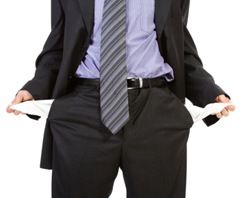 It is always distressing for me to hear about any business filing for bankruptcy. The normal reaction is to assume the business failed because it could not make money when in some cases the business plan was actually good, just too much cost or too high salaries (or in a growing number of cases, too much large investors demand for their ROI) all caused the debt to climb. Unfortunately, today, businesses find the work-around solutions to their economic problems is to file bankruptcy.
It is always distressing for me to hear about any business filing for bankruptcy. The normal reaction is to assume the business failed because it could not make money when in some cases the business plan was actually good, just too much cost or too high salaries (or in a growing number of cases, too much large investors demand for their ROI) all caused the debt to climb. Unfortunately, today, businesses find the work-around solutions to their economic problems is to file bankruptcy.
I am all for protection of business assets so a business can continue while working out of a hole and if there is no other solutions to the problem, but in the case of the private golf clubs and resorts who filed bankruptcy over the past year there were plenty of alternatives they could have explored. Who does these bankruptcies protect and who do these bankruptcies really hurt?
Does It Have To Happen?
The recent news of the bankruptcy filing of several of the country’s more upscale private golf clubs and resorts leads one to possibly assume the filing for bankruptcy was part of these facilities’ original business plan. With the billions of dollars of indebtedness reported in these filings’ it is obvious someone is going to take a big loss. But who?
From speaking with attorneys who deal with large corporate bankruptcies it is usually the small businesses involved in theses case, who are owned millions of dollars, who stand to lose the most. In today’s economy the small business owner, who support private golf clubs, represents the majority of the businesses driving today’s golf economy. It stands to reason if these small business take a beating so does any economic recovery for the golf industry.
Those Who Have the Most Loss Little
In a going number of cases on the books today the protection given under the law is for someone, or a group of business people, who have access to millions of dollars of funds. Does bankruptcy hurt them? Not really. In most cases filing bankruptcy to these savvy business groups is no more than a slap on the hand and is looked at as just one of the hassles of doing business. The failed reputation is hung on the corporation or group’s brand, not the individuals of the group.
The usual outcome is somewhere someone is going out of business as a result of money owned them not paid. As indicated, more than likely, the small business people who service these private golf clubs, golf courses, golf facilities and golf resorts will be the businesses forced to fold up shop, or continue the travesty with them also contributing to the cascade of bankruptcies. These small business owners are the people and businesses who get hurt.
Golfers Bailout
But, there is another group business people who are outsiders to these bankruptcy proceedings who also get hurt whenever a golf club or resort files for bankruptcy. These are the Golfers of the world. The reaction to avoid playing golf at a facility that filed for bankruptcy is normal. The question in golfers minds naturally would be..why would I want to build a business relationship with a golf facility that cannot pay its bills? Eventually, as more and more facilities raise their prices, or reduce their prices as part of some temporary promotion to draw in huge crowds, the golfers who frequent the facility give up on playing golf there which then generates the ultimate question..What golf business can stay in business without golfers?
So what happens to these golf facilities once they go through the bankruptcy process? Usually a private golf facility forced into bankruptcy turns to becoming a Public Golf facility and starts charging green fees instead of membership dues. As a result they get the curiosity seekers who stop by, spend no money outside of the green fee and never return. In the next step the discounts daily fees begin or the facility affiliates with a tee-time or a member for a day service. In a short time the quality of the experience of playing golf at the facility is reduced. Or, the discounting of daily fees draws in huge crowds to the tee-sheet but the management company is forced into 5 minute tee times to cover revenue losses from the discounts and here come the Pace of Play issues which are the kiss of death for any golf facilities. The interest of the golfer wanes and the now public golf facility usually ends back in bankruptcy or closes.
Who losing again when this happens? Yes, the Golfer. Over time as more and more golfers give up their weekly golf outings the golfing populations falls below what will support any expansion of the golf industry. Then the golf manufacturers fall short on their profits resulting in the continual downward spiral of the golf industry…all because a few groups of well healed business people file for bankruptcy so they can fly off to start another business in the golf industry that more than likely is distend to also fail.
Are there alternatives to these bankruptcies? Is there something these financially troubled golf facilities can do to avoid bankruptcy? All are good questions and are questions private golf facilities need to ask before the need for asset protection is needed. Of course many will point towards the need for bankruptcy laws to be changed so the well healed business people do not walk through the system as part of their job. Some see the laws are good just need to be enforced. Either way, the problem is in the people who run these groups more than in the system built for all of us to use.
The bottlomline is the private golf clubs and resorts need to be looking at alternative revenue sources before they run out of time. Many need to find ways to throw off the debt before filing for bankruptcy. Overall, many upscale golf resorts need to look to diversifying their real estate and looking for more out of the box thinking people to manage their business. These are just a few solutions that pop in my head, I am sure you have a few as well.
What is really at stake is golf’s survivability. If more hits are taken in the golf arena by more of the top golf facilities continuing to close, less interest is going to develop in the new golfers who look to these facilities as where they would like to play someday. There are not enough rich millionaires left after 2008 to uphold the volume of these facilities build in the last 10 years, so these private golf facilities are going to have to do something. Lord forbid they look to lower prices…too easy of a solution, isn’t it?
Let me know how I can help.












Regarding cart path only here is a different take. Stop overseeding fairways. Financially wasteful. Less water use in areas that are drought prone. Play is faster as the ball rolls out on dry days and the increased distance brings more strategy into play. In wet or frost conditions carts can get onto the fairways sooner as the base soil is dryer.
Stretch,
Thanks for your support. Good point!